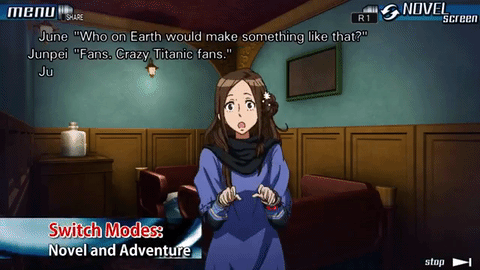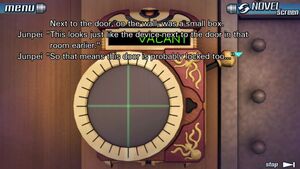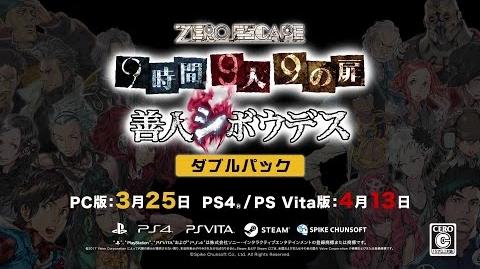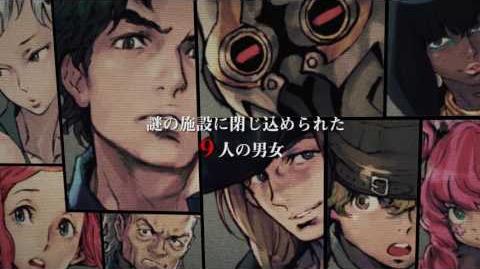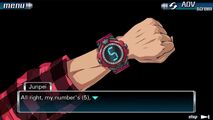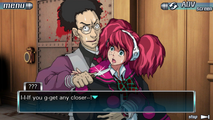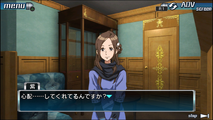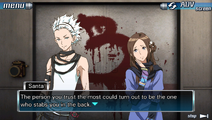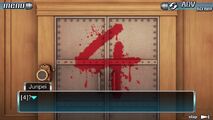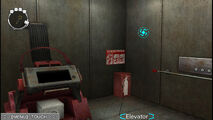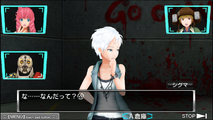Zero Escape: The Nonary Games is a bundle containing a remastered version of Zero Escape: Nine Hours, Nine Persons, Nine Doors and Zero Escape: Virtue's Last Reward for the PlayStation 4, PlayStation Vita / PlayStation TV and PC on Steam.
In North America, Aksys Games released all three versions simultaneously on March 24, 2017.
In Japan, Spike Chunsoft released the PC version first on March 24, and the PlayStation 4 and PlayStation Vita / PlayStation TV versions were released on April 13.
In Europe and other regions, both the PC version and PlayStation 4 version were released on March 24. However, Aksys has acknowledged finding the physical PlayStation 4 version can be difficult, but have linked to a site.[1] The PAL Vita version is slated for Q4 2017, although physical/digital is unspecifed.[2]
The Nonary Games is essentially the definitive way to experience both 999 and Virtue's Last Reward. The original Vita version of Virtue's Last Reward remains on PlayStation Store, although The Nonary Games version is recommended over it.
The Nonary Games makes Vita and PC the only platforms capable of playing all three versions of the game (counting the 999 remaster), since there is no PS4 port for Zero Time Dilemma currently, although Nintendo 3DS owners can still play the original DS version of 999 without the remastered features.
SPOILER WARNING
Do not click any links on this article if you wish to avoid spoilers.
Content, additions and changes
- All versions of The Nonary Games bundle 999 and VLR, whether it be on a download, disc or cartridge -- individual releases are non-existent.
- All versions of The Nonary Games feature English and Japanese dual audio for both games, an improvement over the first European releases of VLR missing one dub. Only English and Japanese dubs and text are supported. The voice cast is listed below.
- Both games feature individually adjusting the volume of (or disabling entirely) voices, sound effects and background music. If the player chooses to disable voices, in both games, there are no voice beeps outside of escape rooms, with the exception of Sigma in VLR.
- Both games feature menus with button prompts catered to each system. For example, only PlayStation buttons exist in the PlayStation Vita and PlayStation 4 versions. The PC version allows for generic keyboard and mouse buttons, generic gamepad buttons, or PlayStation buttons.
- Both games feature a "skip text" function in the options which allows returning players to fast-forward segments, even on a first playthrough.
- Both games feature trophies/achievements with a shared list.[3]
- Both games feature 30 save slots for each game, an improvement over the one save slot in 999 DS and the 1 or 3 save slots in VLR.
999
999 remastered contains:
- Escape rooms are included, unlike the iOS version.
- HD art. The developers either professionally extended the art to widescreen, or had original assets in widescreen available, resulting in a perfect 16:9 widescreen presentation.
- HD characters with animations adapted from the DS version. The iOS version lacked moving animations, but it had higher quality still frame images. The remake takes the best of both worlds with animated HD sprites.
- Higher quality music compared to the DS version, as was in the iOS version.
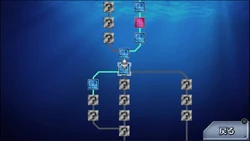
The 999 FLOW Chart.
- A FLOW Chart which now prevents players from having to replay the entire game from the beginning and redoing the escape rooms to earn the different endings. The FLOW Chart allows the player to play sections of the escape rooms and redo their decisions in them. The FLOW CHART judges the player based on the latest decisions made.
- First-time players may wish to avoid looking at the FLOW Chart until they receive their first ending, as how the paths connect may be considered a minor spoiler for some.
- Auto-advancing textboxes similar to Virtue's Last Reward, so players don't have to tap and click as much as they had to in the DS version. They can just sit back, relax and enjoy the visual novel segments.
- Memories of the Escape returns. It is unlocked when the player receives their first ending.
- There are no extra endings, and the Syringe Ending from the iOS version does not appear. There is no major additional story content.
- There is now a hint button in certain minigames.
- The "Safe Ending" has been renamed "Zero Lost".
- Fix various mistakes and typos (for specifics, visit the "mistakes" article)
- There is no Memo function seen in Virtue's Last Reward, although there is nothing in 999 that a pen and paper can't handle.
- The Calculator is available, allowing the player to perform math calculations and digital root calculations in-game.
- The solution to the first part of the brain adjustment mini-game in the torture room has been altered (the second part remains the same).
- The final puzzle is different.[4]
| SPOILER WARNING - DO NOT CLICK UNTIL DOOR 3 IS ENTERED | |
| |
| SPOILER WARNING - DO NOT CLICK UNTIL THE GAME IS COMPLETED | |
| |
Novel and Adventure Mode mechanic
One of the major changes to 999 is the use of Novel/Adventure mode, which are workarounds of the Nintendo DS's original use of dual screens. 999 originally took advantage of the DS's two screens.
The player may choose between game "ADV" ("Adventure") and "NOVEL" mode:
- Adventure mode features constant talking like a real-time conversation with speech subtitled in the textbox at the bottom of the screen.
- Novel mode adds the narration originally seen on the DS' lower screen, allowing for a more thought-based commentary between conversation. Textboxes are absent and, instead, it is presented like an eBook.
This is different than the original DS game's approach which used dual screens; what is seen as "ADV" was actually the top screen, and "NOVEL" was the bottom screen. The player can switch between them, although some segments will switch automatically so that important information and dialog is not missed. Any essential text in Novel mode (that was originally in narration for the DS version) is either reworked into Adventure mode, or it is part of a mandatory string of narrative text (that, if the user is in Adventure mode, will switch to automatically, and the player will not be able to return to Adventure mode until the mandatory part changes).
This will act as a workaround for concerns about how the story will be presented.
Additionally, a bluish filter of rays will appear on the screen to indicate something Junpei is thinking, but not saying (voiced).
Virtue's Last Reward
As VLR already contained voice acting and HD art, it is not surprising that there are no new features for VLR. VLR is more of a straight port from the Vita version.
VLR confirmations include:
- Certain typos have been fixed. "Donno" has been changed to "dunno".
- The Vita version of Virtue's Last Reward was criticized for having English voices be lip synced to the Japanese dub, making it inaccurate, which wasn't an issue in the 3DS version. Unfortunately, The Nonary Games does not fix this due being a port of the Vita version, and overhauling the entire lip sync would be technically difficult. This is not an issue if the player uses the Japanese dub.
- Likely for continuity purposes, the voice of Akane in the ending is Rena Strober's (Akane's voice actor in the 999 remaster and Zero Time Dilemma). Akane's voice in the original 3DS/Vita version was Ali Hillis in the end or beginning.
- Original version (Ali Hillis)
- Re-dubbed version (Rena Strober)
- Despite the above, Diana is still voiced by Laura Bailey instead of Eden Riegel in the Mars Mission Test Site recording.
- Another Time ending, which has since been revealed as non-canon, returns. At the end of the ending, however, it says "Alternative End" instead of "End or Beginning" to help make it clearer that Another Time end is non-canon.
Reception
The Nonary Games is generally considered a competent port of 999 and VLR. It has a Metacritic in the 80s for all versions. Some PC players experienced technical issues such as crashing and a few patches were released to fix these bugs.
Trivia
- The game was released on March 24th (03/24). 0 + 3 + 2 + 4 = 9. It is unknown if this was intentional or not.
- English 999 came out on DS on 11/16, Japanese VLR came out on 2/16, and Japanese PC version of ZTD came out on 6/30.
- The game was announced at Anime Expo 2016 during the Zero Escape panel. The announcement was in the form of a gameplay video[10] that demonstrated, with Japanese voice acting (but English text), the scene in the Steam engine room during one of the alternate pathways (not mandatory to get all the endings) in which Santa narrates the story of the "black Santa" and "white Santa". During the end of the gameplay video, the script deviates from the original script and features the four present characters (Ace, Junpei, June and Santa) breaking the fourth wall and talking to the panel's onlookers.
Voices
If you have not finished both 999 and VLR, DO NOT click the character links below - their articles have spoilers.
Nine Hours, Nine Persons, Nine Doors
| Character | ||
| English | Japanese | |
| Ace (1) | Richard Epcar | Takaya Hashi |
| Snake (2) | Taliesin Jaffe | Takahiro Sakurai |
| Santa (3) | Sean Chiplock | Kishō Taniyama |
| Clover (4) | Wendee Lee | Yukari Tamura |
| Junpei (5) | Evan Smith | Tatsuhisa Suzuki |
| June (6) | Rena Strober | Miyuki Sawashiro |
| Seven (7) | Edward Bosco | Kenta Miyake |
| Lotus (8) | Valerie Arem | Rie Tanaka |
| 9th Man (9) | Cam Clarke | Nobuo Tobita |
| Zero | Unknown | Unknown |
Additional Japanese voices include: Eimi Okada, Yurina Watanabe, Yuka Adachi, Saori Terai, Mai Nishikawa, Yuuki Kuwahara, Minami Iinuma, Show Okumura and Takaki Otomari.
Additional English voices include: Julia Arem and Kyle Arem.
Virtue's Last Reward
| Character | ||
| English | Japanese | |
| Phi | Karen Strassman | Chiaki Omigawa |
| Alice | Tara Platt | Atsuko Tanaka |
| Luna | Laura Bailey | Mamiko Noto |
| Dio | Liam O'Brien | Yoshimasa Hosoya |
| Quark | Erin Fitzgerald | Rie Kugimiya |
| Tenmyouji | J. B. Blanc | Rokurō Naya |
| Clover | Wendee Lee | Yukari Tamura |
| K | Travis Willingham | Daisuke Ono |
| Zero III | Cindy Robinson | TARAKO |
External links
- English site
- Japanese site
- The Nonary Games on PlayStation Store (PS4)
- The Nonary Games on PlayStation Store (Vita)
- The Nonary Games on Steam (PC)
- The Nonary Games on PCGamingWiki

